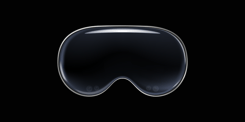The launch of Apple’s Vision Pro VR Headset was met with high expectations and significant hype. Yet, the $3,500 price tag and the reality of its market reception have painted a different picture. Apple recently cut sales projections in half, from 800,000 to 400,000 units, translating to a potential $1.4 billion revenue loss. So, what went wrong with this highly anticipated product from one of the world’s most innovative companies?
At Yulio, we have always envisioned VR as a tool to enhance communication, streamline processes, and foster collaboration in practical business settings. This perspective stands in stark contrast to the consumer-oriented approach taken by Apple and many other tech giants. Let’s explore why a focus on practical VR business use is the right path for VR and where Apple might have misstepped.
The Vision Pro's Market Misalignment
Apple’s Vision Pro was designed as a high-end, immersive experience intended to transform how we interact with digital content. However, the headset’s hefty price and niche market appeal proved that the consumer market isn’t interested in spending a lot of time in VR yet. We consider this no surprise - VR is best used as a communication tool, and in a practical business approach is more about communication than long immersive solo experiences. In short, at Yulio, we’re not surprised that the Apple approach isn’t what people wanted to do with VR.
The recent ads from Apple mostly market to everyday consumers
VR for Business: A Practical Approach
The initial marketing for VR was often sensational, depicting people lost in virtual worlds, amazed by the technology's ability to transport them elsewhere. This created an unrealistic standard where anything less than total immersion was seen as a failure. However, as the technology evolved, so did its practical applications.
VR as a Communication Tool
At Yulio, we envision VR as a tool that enables users to pop in and out of virtual environments seamlessly. This approach aligns with the everyday needs of businesses, where VR can be used to quickly review a 3D model with colleagues, or walk through a design with clients, ensuring everyone is on the same page.
This practical application contrasts sharply with the Vision Pro’s aim to integrate VR into daily life tasks, such as cooking or relaxing. Those use cases, while innovative, fail to address the core needs of most consumers and businesses. Instead, they position VR as an unnecessary luxury rather than a practical tool.
Affordability and Accessibility
One of the critical factors in the success of VR for business has been the development of affordable, standalone headsets like the Quest from Meta. These devices offer six degrees of freedom and substantial computing power without the need for cumbersome cables or expensive setups. They are designed to be user-friendly and accessible, making them suitable for various business applications.
Apple’s Vision Pro, with its $3,500 price tag, places it out of reach for most businesses and consumers. The high cost creates a barrier to entry, limiting its adoption and undermining its potential impact. In contrast, Yulio’s approach has always been to provide cost-effective solutions that deliver real value to businesses.

The Meta Quest 3 is $500 and offers a very robust mobile VR experience that is a bit more affordable
Learning from Apple’s Experience
At Yulio, we always intended VR to be a tool for quick, impactful interactions. It's meant to be used to pop in, have a conversation that puts everyone on the same page, and then pop out. We never envisioned VR as something to be used for extended periods, like cooking in VR. Instead, it’s about creating great conversations where clients have a full understanding and can ask better questions.
Here are some key takeaways for architects considering VR in their business that doesn’t require a high cost of entry:
Use VR to Get Decisions Made: VR can facilitate decision-making by providing a clear and immersive way to present design concepts. When clients can visualize the end result, they are more likely to understand the proposal fully and make informed decisions quickly. This reduces the back-and-forth and speeds up the approval process.
Use VR to Stand Out from the Crowd: In a competitive field like architecture, standing out is crucial. Incorporating VR into your business can set you apart by offering an innovative and engaging way to present your designs. Clients will appreciate the modern approach, and it will differentiate your firm from others that rely solely on traditional methods.
Draw Attention at Trade Shows: Trade shows are an excellent opportunity to showcase your firm's capabilities. A VR presentation can draw significant attention to your booth, allowing potential clients to experience your designs firsthand. This interactive experience can leave a lasting impression and generate more leads.
Enhance Client Understanding: One of the most significant benefits of using VR in architecture is that it helps clients understand complex designs. When clients can virtually walk through a space, they gain a better sense of scale, materials, and layout. This comprehensive understanding leads to more insightful questions and a smoother project progression.
Conclusion
While Apple’s Vision Pro represents a significant technological achievement, its failure to resonate with the market underscores the importance of practical VR. At Yulio, we believe in the power of VR to transform business communication and collaboration, and we have designed our solutions to be practical, accessible, and aligned with the needs of our users.
By focusing on these principles, we ensure that VR remains a valuable tool for businesses, helping them achieve their goals and stay ahead in an increasingly competitive landscape.
Focus on practical, everyday uses of VR that enhance productivity and communication in business settings. This pragmatic approach ensures that VR becomes an integral part of your workflow, rather than a novelty.




.jpg?width=245&height=150&name=andre-francois-mckenzie-rz2YF0vBsvA-unsplash%20(2).jpg)
.jpg?width=245&height=150&name=activity-analytics-business-plan-401683%20(1).jpg)
